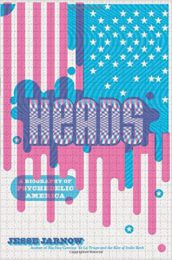Psychedelic drugs, most prominently LSD, can be credited for having changed Americans and American culture forever. Hardly anything else in the last 60 years has had such a strong influence on American culture as a whole, meaning it had the power to influence the arts (in particular, music), politics, spirituality, technology and naturally a high number of individuals (one could put it that way).
 Jesse Jarnow tells a very long tale of the influence of the substances on American bohemian artistic centers such as San Francisco and New York and recovers endless stories about the many concerts of the San Francisco cult band The Grateful Dead.
Jesse Jarnow tells a very long tale of the influence of the substances on American bohemian artistic centers such as San Francisco and New York and recovers endless stories about the many concerts of the San Francisco cult band The Grateful Dead.
For some 30 years, their music created a very particular audience that was usually truly fond of drug experiments, with the hardcore fan known simply as “Deadhead,” or just “Head.” The band and their achievements are the perfect vehicle to tell the story of US counterculture that would have been impossible without mind expanding drugs such as LSD or marijuana.
The story of the Heads, therefore, is deeply connected to the change in American society on a spiritual level. Even for the readers who are strangers to the Grateful Dead, this book reveals countless connections between events, persons, concerts, political rallies and how they all somehow were affiliated; again by other events, sometimes the same people and an attitude that would have been impossible without the assistance of mind-enhancing substances.
Jarnow tells a story of “… how psychedelics – both the idea and the ideas it provoked – disseminated into the American consciousness long beyond the sixties, and how these ideas would eventually play out in the daily life of entire regions of the country. Together, they make an ethnographic comic book history.”
At times, his book reads like a novel (some events seem way too fictional, but then … funny things happened in the 60s and 70s), and it is very hard to put it down. It starts with the main events such as the early, legal sale of LSD and peyote, the Grateful Dead playing at Kesey’s weekly acid test parties and ends with post-Garcia Dead activities worldwide.
In the second part of the book Jarnow devotes a reasonable part to the 1990s, a time when there was the second massive wave of acid related arts and prominent trippers.
And he comments on the LSD revival of only a few years ago, during which the drug (and very similar substances as magic mushrooms and entirely synthetic products) was very easily available online. The book is also loaded with extremely detailed accounts of all economic aspects of the American counterculture, such as the invention of a (national) drug industry and market, distribution chains, military uses and the special interest of the intelligence services in the product. Research on these procedures alone must have taken years.
Between those accounts come the reviews of concerts, festivals, tours, art projects and many innovations, publications, technology presentations and developments that all somehow were related to the drug-induced experiences of their inventors.
Far from being simply a Grateful Dead chronology or a Deadhead almanac, Heads is the fascinating story of the American drug counterculture and their many artistic explorations. Jesse Jarnow is a popular author from Brooklyn, who contributes to Rolling Stone, Wired, Relix and The Village Voice on culture, music and technology.
Review by Dr. A. Ebert © 2016
Jesse Jarnow. Heads: A Biography of Psychedelic America. Da Capo Press, 2016, 512 p.
